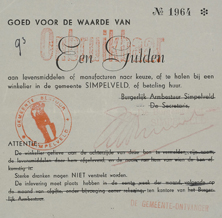Emergency money issues of the Second World War > Historical Background
In the early hours of 10 May 1940 the German forces invaded the Netherlands. The Germans managed to occupy the eastern part of the Netherlands within two days. The Rotterdam bombings broke the Dutch resistance: on 14 May 1940 the Dutch army capitulated. Fighting continued in the Province of Zeeland. Together with Belgian and French troops they held out against the advancing troops. The Germans, however, pushed on and on 30 May 1940 the last part of Zeeland, Zeeuws-Vlaanderen, became occupied by the Germans.
Shortage of money
The occupation directly resulted in a shortage of money. The Nederlandsche Bank wanted to prevent the stock of money from its various agencies falling into the hands of its enemies. This is why they sent the money to their head office in Amsterdam. If this was not possible it was destroyed.
Civilians tried, where possible, to keep their silver rijksdaalders (2.5 guilders) and guilders. In addition, they tried to exchange as many of their banknotes as possible into clinking coins. This resulted in a great shortage of, in particular, lower denominations in the early days of the war. The introduction of “paper coins” was to solve this shortage.
However, because of the combat operations the transport possibilities were uncertain. Poor accessibility meant people were afraid that the government would be unable to transport sufficient zilverbon banknotes everywhere. This resulted in the issuing of emergency money.
Authorization for emergency money
The central government was aware of the problems. They telegraphed the provinces and municipalities as early as 11 May 1940 that they were authorized to print and issue emergency money.
However, as of 15 May it turned out that the Nederlandsche Bank was already in a position to provide the entire country with banknotes and zilverbons. The authorization was therefore withdrawn on 17 May.
Not all of the emergency money was immediately demonetized. Some municipalities even circulated money after 17 May. It can be established, however, that all the money had been repossessed by the end of May.
During the Second World War emergency money was issued on a very small scale a few more times. In 1941 a few batches of coupons with the value of 10 and 25 cents were issued because some regions had a great shortage of coins with these values. In some municipalities emergency money was printed in 1944 but was eventually never brought into circulation.


